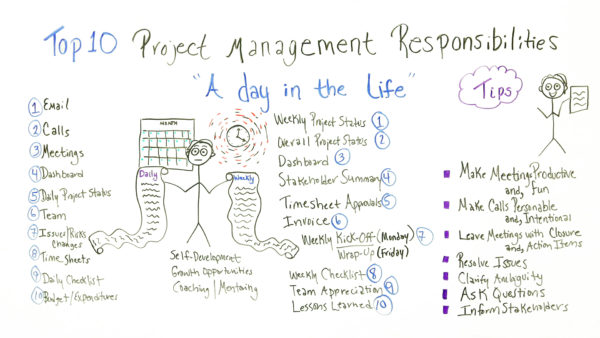There are many responsibilities for project managers, from leading teams to tracking projects to reporting on progress. Jennifer Bridges, PMP, focuses this video on the daily and weekly job duties for PMs.
Here’s a screenshot of the whiteboard for your reference!

In Review – Top 10 Project Management Responsibilities:
What’s a day in the life of a project manager like? Jennifer asked. Well, there’s a lot of responsibilities. Jennifer made a top-10 list for both the daily and weekly chores.
Daily Tasks
- Emails: Whether you love or hate them, people still disseminate vital project information via email. You can’t afford to let some crucial piece of information slip through the cracks.
- Calls: There are going to be calls you need to take and others you’ll need to make to stay in contact with various people on the project team.
- Meetings: Meetings are another avenue to deliver your message to the team writ large or stakeholders and sponsors.
- Dashboard: You’re always going to want to get this bird’s-eye view of the project’s progress, and this is your one-stop shop for all those important metrics.

- Daily Project Status: One metric that is super-important is the project status, and noting where you are compared to where you planned to be now.
- Team: Check-ins with your team is a great way to get a barometer of the project from the ones who are on the front lines.
- Issues/Risks: You’re going to have one eye constantly focused on what issues are coming up and if any of the risks you identified are in fact occurring.
- Timesheets: By keeping daily timesheets you’re able to have a more accurate picture of the project’s progress.
- Daily Checklist: One way to keep track of all the work you have is to make yourself a daily checklist, which means you’re less likely to miss something.
- Budget/Expenditures: How much money did you budget to spend at this point in the project, and how much have you in fact spent?
Weekly Duties
- Weekly Project Status: Just as you look at the day-to-day progress of the project, you must track its weekly progress as well.
- Overall Project Status: You want to also look at the overall status of the project to determine where you might need to address issues.
- Dashboard: The dashboard is a daily and weekly stop, being that it’s giving you a moving picture of the project’s progress.
- Stakeholder Summary: Your stakeholder is going to want a report, which you can generate easily from the dashboard.
- Timesheet Approvals: You’ve been tracking time with your daily look at timesheets, but now you’re going to need to approve them, so your team can get paid.
- Invoice: The same goes for invoices that have piled up over the week.
- Weekly Kickoff/Wrap-up: On Monday’s you’ll want to start the week with a look forward and at the end of the week have a Friday wrap-up to see how you’ve done and address any issues for the coming week.
- Weekly Check-in: Like your daily check-ins, you’ll want to have a more structured and far-reaching one for the week.
- Team Appreciation: Don’t forget to note milestones and give your team the attention they deserve for a job well-done.
- Lessons Learned: Take some time to look back and sum up what went right and what went wrong, and learn from both experiences so you can boost the good and minimize the bad.
Related: Lessons Learned Template
Tips for Daily PM Success
Jennifer didn’t just leave you with some task lists. She also offered some tips to help you along the way.
- Make meetings productive and fun to keep moral and engagement high.
- Make calls personal and intentional to build relationships and not waste people’s valuable time.
- Leave meetings with closure and action items so team members can hit the ground running.
- Resolve issues, because a lingering issue isn’t going to go away by itself, and will likely only get worse.
- Clarify ambiguity to make sure everyone is clear on what needs doing or what the current state of the project is.
- Ask questions, because by staying curious and engaging your project team you learn and lead a better project.
- Inform stakeholders, as transparency makes for a happier stakeholder. No one wants to feel out of the loop, especially those who are funding the project.
Pro-Tip: That’s a lot of work on a daily and weekly basis, and of course it’s not everything that a busy project manager must do. That’s why you need personal time management. An effective method is the OATS principle, where you track Outcomes, Activities, Timing and Schedule.
Thanks for watching!
Transcription:
Today we’re talking about the top ten project management responsibilities. Well, you can find lists out there of these responsibilities, but specifically today, I wanna focus on daily and weekly tasks.
In essence, people wanna know what’s the day in the life of a project manager? What do I do, again, daily and weekly? And so, when we look at daily responsibilities, we’re looking at things like email, returning emails, or sending emails in a timely manner, making any kind of calls that you need to as follow up or if someone calls, just again following up with them or calling to ask questions to clarify things.
Another is meetings. So, sometimes you have meetings with, it could be the team members, or any kind of third party, vendor partners, or even your stakeholders.
Also, keeping an eye on your dashboard, so a dashboard is a graphical picture of how your project is doing. So, you wanna look at things like how are we doing on our timeline, how are we doing on our budget, how are we doing on delivering the scope, and those type of things that we wanna watch on our dashboard.
We also want to track the daily project status, like where are we supposed to be today? So, if there are tasks that are supposed to be completed today or even milestones, take a look at where you are. Are you in progress, are they completing as scheduled?
Also, it’s great to take a check-in on your team. Check in with your team and make sure they’re not stuck. Sometimes, team members could be stuck, maybe they’re waiting on information from another group that you maybe could help resolve or escalate, or they may need some training, or they may just be stumped on how to approach a different task that they’re working on.
Also, making, ensuring that issues, risk, and any changes are being addressed. You wanna make sure they’re logged and being addressed by the project team.
Also, timesheets. We found that if timesheets are done daily, your information or your time is being tracked more reasonable, instead of waiting more until an extended period of time. So, if people log their time at the end of the week, or at the end of the month, or even longer periods of the project, we find that it gets to be more of a guesstimate.
So, we also want to keep a daily checklist, things that you want to ensure that by the end of the day that you resolve. And then also keeping an eye on your budget versus your expenditures, because the closer that you can keep those things resolved, the better.
So, also we wanna look at what are some of the weekly things that we do. So, we also…there’s a daily project status, but also a weekly, like through the week, are we where we’re supposed to be?
Also, the overall project status, so at this point in time, say in this period of time of this week, are we where we’re supposed to be in the overall scheme of the project? If not, begin resolving those issues and finding out where the issues or problems may be.
Also, again, monitoring a dashboard on a weekly basis to ensure graphically those components of your budget, your scope, the timeline, all of those things are being on track.
Also, providing a stakeholder summary. We found by keeping our stakeholders informed, it keeps them at ease that the project is keeping on track, and that any issues are being resolved, because we may need at times their input into things. They may need input on maybe some changes, the change control board to make sure that changes are addressed and decided.
Also, the timesheet approvals. Typically on most projects, the timesheets are approved at the end of the week, so that invoicing can be done. So, invoices may be sent to the client, they may be sent to third parties, and so that you wanna keep that going on a regular basis.
So, also a weekly kickoff. I start my Mondays by looking at for the week, what are the things that week I need to do, and for the wrap-up on Friday, I look at all the things I was due to complete that week, did I complete them? If not, do I need to carry over to the next week? Do I just need to close them out? Are they still important, or are they not important anymore?
So, I clean that list up, so I start the next Monday, so it’s kind of rinse and repeat the Monday through Friday. And then also having a weekly checklist.
And then also being able to invoke some team appreciation. Keep your team encouraged, keep them inspired, and just acknowledge them for the work that they’re doing on the team.
And then also tracking lessons learned, because what we found is with lessons learned, you want to incorporate them as soon as possible along the way, instead of waiting until the end of the project, and capturing those lessons when it’s really too late.
So with that, we also know that through, it may not be daily or weekly, but it’s really ongoing, is to continue your self-development, any kind of growth opportunities, and coaching or mentoring, not only for yourself but also for your team.
And then also for these, I guess I have some extra tips as well. So, remembering that to make meetings productive, start them on time, end them on time and, most of all, have fun.
So, you can work hard and have fun. And then make calls personable and intentional. If you make calls or set up a call, be sure that you set the intention, so that the other person knows like why are we having this call, what’s the intent, what does everybody wanna leave with? Is it just information, or do you need to leave with a decision?
Also, leave meetings with closure and action items of knowing who’s supposed to do what, when, and where. And then, resolve issues. Don’t let issues keep building and lingering on because they typically get worse as they go. Clarify any ambiguity, because if you leave things unclear, then it just, if people are not sure what they’re working on, or maybe not clear on expectations, again, it just causes trouble down the line.
And then ask questions. Just continue to ask questions of your team, of your vendor partners, of your stakeholders. That provides a lot of information and just keeps people accountable to what they’re doing. And also, keeping your stakeholders informed always helps.
But if you need a tool that can help you with your daily and weekly task and responsibilities as a project manager, then sign-up for our software now at projectmanager.com.



